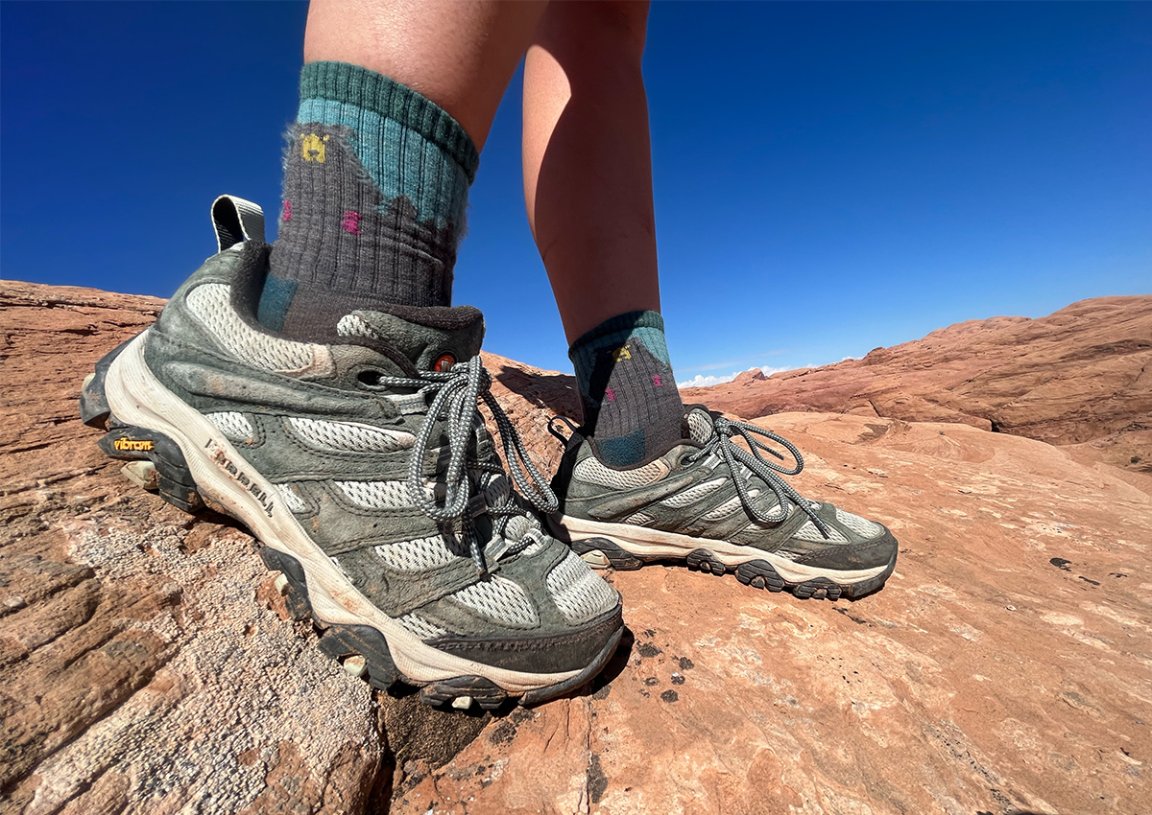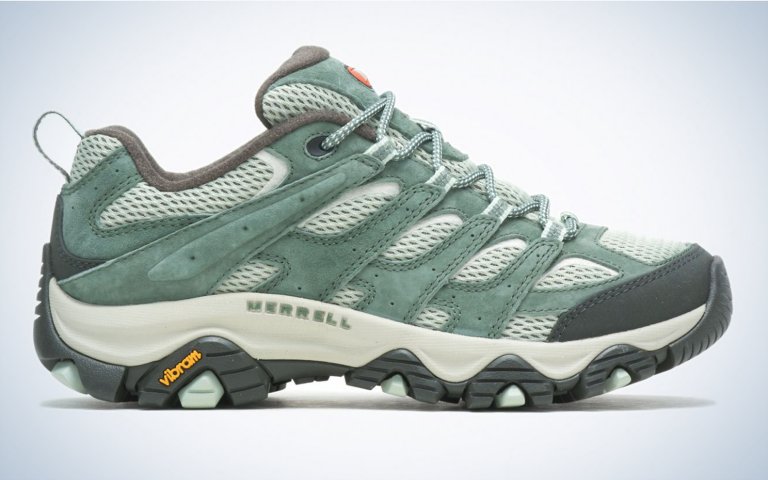We may earn revenue from the products available on this page and participate in affiliate programs. Learn More ›
The Merrell Moab has a great reputation for out-of-the-box comfort and an affordable price. It is the most popular budget hiking shoe. However, I wanted to see what hikers could really expect from a budget shoe. So I decided to destroy them using the forces of nature and a reckless attitude.
To celebrate the newest edition, the Moab 3, I put Merrell’s claims of improved comfort, stability, and traction to the test. My plan was simple: Find some truly rugged terrain. Adopt a complete disregard for my footwear. And send every sketchy side quest I could find. I completed the first step by selecting one of the harshest hiking locations in the contiguous United States featuring slickrock, abrasive sand, and technical routes, the shoe’s namesake, Moab, Utah.
Merrell Moab 3 Hiking Shoes Specs and Features
Merrel Moab 3
See It- Weight: 1 pound 10 ounces
- Drop: 11.5mm
- Lug: 5mm
- Merrell Air Cushion heel
- Vibram® TC5+ outsole
- 100 percent recycled laces and webbing
- Bellows tongue keeps out debris
- Available in a waterproof version
The Moab 3 thrives in three main areas: shock absorption, traction, and keeping out debris.
Shock Absorption
If your heel is the first part of your foot to touch the ground, then you’ll benefit from this shoe’s high drop which will keep the stress off your feet and calves. The reinforced heel cushioning, molded nylon arch shank, Super Rebound Compound, and Vibram TC5+ outsole all work together to create a stable and protective platform for your foot. Merrell even makes a mini-me version of the Moab for kids’ hiking shoes in the Little Kid’s Trail Quest Jr. to protect little feet on the trail.
Traction
The upgraded lugs, deep tread, and specially formulated Vibram outsole provide substantial grip on slick surfaces. These same features also cling to mud and sand, but the stability is worth scraping some dirt off every so often.
Keeping Out Debris
Thick walls, high backs, and the strategically designed tongues do a great job of keeping the inside of the shoe free from pesky rocks or an excessive amount of dirt or brush. The upper mesh and laces also keep out unwanted debris even in deep sand.
Testing the Merrell Moab 3 Hiking Shoes in the Field


While all of these features sound fantastic and perform admirably, I couldn’t help but wonder if the Moab would hold up in the durability department. Afterall, the compromise for these other great qualities has to come from somewhere, right? So, I set out to royally wreck this brand-new pair of one of the top hiking shoes in a single weekend. In my opinion, the best way to destroy a pair of hiking shoes in the shortest amount of time is by canyoneering in them.
I rappelled into deep canyons descending anywhere from 60 feet to 130 feet at a time, sliding my shoes on slick rock the whole way down. I downclimbed and scrambled over massive boulders, sometimes in the rain. After the shoes went swimming a few times, I traipsed through rough sand and jammed my feet into sharp cracks and crevasses. I stood on steep inclines for prolonged periods of time helping others lower themselves off boulders, relying on the grip of my shoes and tension between the rock to coach and sometimes hoist fellow hikers through narrow spots. Foolishly, I thought that bouncing across rocks, scraping my toes into barely-there holds, and dragging my feet through mud and gravel would result in some kind of mesh and rubber carnage.

But after three days of testing, including three canyons and five rappels, I managed to slightly fray a single shoelace. I most likely only managed this damage because I overly tightened the shoes to achieve my optimal fit.
A running theme with Merrell shoes is their extra width. This shoe is roomy but not in a dangerous or uncomfortable way. It allowed my toes to splay as I bounced from rock to rock, providing peace of mind in my stability. However, it did cause the laces to work double time.
Dreams of peeling outsoles, ripped mesh, and tearing seams danced in my head as I crawled through tight rocks, stemmed across keeper holes, and stomped through muck, but alas, I failed to destroy this budget beast of a shoe. Instead, I found myself grateful for the intense grip, protective toe, and stellar shock absorption. If the Moab’s held up in Moab, you can count on these in almost any terrain.
What the Merrell Moab 3 Hiking Shoes Do Best
These shoes are best for day hikes. They’re comfortable, solid, and able to accommodate wider feet (due to genetics or swelling). Beginner and occasional hikers will get the most out of this affordable shoe. If you’re using them in this capacity, then they will last you for several years of wilderness enjoyment.
I picked the non-waterproof version of the Moab 3 because I knew I would be getting wet on this trip. This might seem counter intuitive, but this trip required more than the occasional romp through small puddles or sprinkling rain. I knew I would be swimming in these shoes, wading through waist-deep water, and braving desert storms where the landscape is prone to flash flooding. Instead of futile attempts to keep water out, I opted for the breathability and easy-draining mesh. The non-waterproof Moab 3 was able to let water quickly pass through, never mind my already soaked socks.
What the Merrell Moab 3 Hiking Shoes Do Worst
The weight and high heel drop are the downfalls of this shoe. These shoes will not perform optimally on longer or speedier hikes like backpacking, summiting, or trail running. The weight will slow you down and cause you to fatigue more quickly. The 11.5mm heel drop will eventually cause you to feel more of the stress diverted from your lower legs in your knees and hips. They’re lighter than a hiking boot, allowing for technical maneuvers, though perhaps not excelling at them. However, if you keep in mind that these are hiking shoes, not trail runners, you’ll be pleased with the Moab 3s.
Final Thoughts
If you’re looking for a three-season, reliable hiking shoe that’s lighter than a boot but sturdier than a tennis shoe, these are the shoes for you. Great for exploring and single digit mileage days, the Moab 3s will keep you comfortable. They’re decently breathable and feel stable underfoot with no break-in period necessary. Afterall, the best day hikes are ones where you’re more concerned with the scenery and who keeps eating around the raisins in the communal trail mix than with what kind of shoes you’re wearing.

